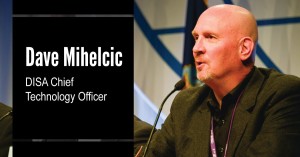
DISA must rely on automation to avoid paving the cyber, IT cow paths
Dave Mihelcic, the recently retired chief technology officer at the Defense Information Systems Agency, said a pilot to test a software defined environment is o...
When leaders at the Defense Information Systems Agency asked Dave Mihelcic to become the agency’s chief technology officer more than a decade ago, he initially was hesitant.
But over the last dozen years, Mihelcic, who retired from DISA on Feb. 3, transformed the role of the CTO from one that was a part time role giving the DISA director limited advice to a position that is bringing DoD to the leading IT edge.

Mihelcic said he is not only leaving the DISA CTO position in a good place, but is enthusiastic about how the CTO’s office is leading major IT advancements for DISA and DoD at large. Mihelcic said Riki Barbour will be the acting CTO until DISA names a permanent one.
He said the biggest change in the CTO’s office came from bringing in the right people to promote innovative approaches to IT.
“We had a notion we wanted to drastically enhance the capabilities of the DISA CTO. We got approval very early on to bring in senior technologists and we brought in some of the best technologists from across the agency in everything from communications networking to computing to software development,” Mihelcic said on Ask the CIO. “Some of the innovation came in later. We recognized that as a gap. We were providing architectures, insight and oversight to DISA programs, but we had no inherent hands on capability, if you will. That was a gap we recognized several years into it and had to bring resources to bear to close that gap.”
As DISA closed those innovation gaps, Mihelcic brought in leading edge technologies to help the military services and agencies.
One such initiative is around cloud. Not only did DISA lead the development of the DoD’s cloud computing strategy and the MilCloud 2.0 acquisition, but it also is testing out software-defined networking capabilities—which many say is the next evolution in cloud.
“The software defined environment looks to integrate and automate all of the technologies in a data center to have one-touch provisioning of entire systems supporting DoD needs,” Mihelcic said.
This software-defined network effort also is the key for DISA to move more heavily toward an agile or dev/ops methodology. Mihelcic said DISA first started using an agile approach in 2010, but without the automation tools to test and verify software, moving to dev/ops wasn’t easy.
“What we tend to do is use techniques like agile but we accumulate updates to the network and then we send through a manual testing and certification cycle, and then manually push them out periodically,” he said. “What we really need to do is focus on the automation piece, both automate the test as well as the security certification, and then automate the deployment of software capabilities so we can match where industry is now.”
DISA is testing these technologies to collect, compile, test and deploy the changes in real time.
“We are about six months into the pilot and we have demonstrated these abilities,” Mihelcic said. “We are starting to spin out the results of that into DISA projects and programs to include our DCS—Defense Collaboration Services. We also are looking at how the global command and control system can adopt some of these techniques, and likewise we are working with our computing ecosystem at DISA to use some of these automation techniques in the operational data centers today.”
He added another goal of the software environment is to help DISA employees create, manage and oversee systems at a great rate. Through automation, he said, system administrators and cyber analysts can understand the health or vulnerabilities of a network more quickly and take action to fix problems.
Along similar lines, Mihelcic said several cyber-related projects are moving forward.
“We in the CTO believe the cloud can be a security force multiplier, using technologies that will allow us to redeploy software instantaneously when a cybersecurity fault is detected. Essentially, the systems can patch themselves and make themselves immune to cybersecurity attacks in real time,” he said. “As part of our software defined environment lab demonstration that we are currently conducting, we have a scenario where a system is somehow attacked and infected with malware. We can detect that automatically and we can essentially reprovision a known good copy of the system without the malware, without the adversary owning the system, and then we can shut the adversary off to a virtualized version of that system and have our cyber defenders watch them in real time.”
Mihelcic said he expects these advanced cyber capabilities to roll out more broadly across DISA over the next 12-to-18 months, especially as the agency modernizes its infrastructure to handle these upgrades.
All of these efforts around software defined environments and cybersecurity helps DoD become more comfortable with moving to the cloud.
Mihelcic said without the automation tools to rapidly provision, deploy and manage these cloud capabilities, then all the Pentagon is doing is “paving the cow paths” because they will continue to use their lengthy, legacy processes.
Copyright © 2024 Federal News Network. All rights reserved. This website is not intended for users located within the European Economic Area.
Jason Miller is executive editor of Federal News Network and directs news coverage on the people, policy and programs of the federal government.
Follow @jmillerWFED






